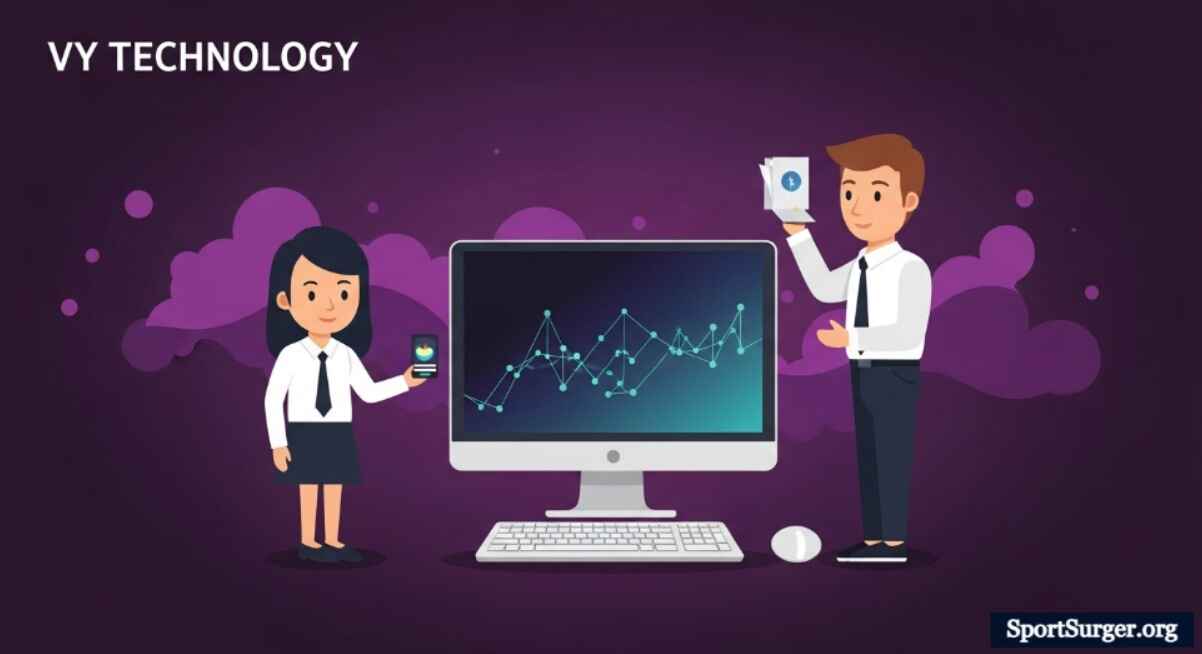Introduction
Imagine telling your computer what to do — “organize invoices,” “summarize this PDF,” “merge these shapes in Figma” — and then watching it execute those requests across multiple apps, without manually clicking, coding, or setting up integrations.
This is the promise of Vy technology: a visual-first AI agent that “sees, understands, and acts” on your computer just like a human would.
In this long-form exploration, we’ll dissect vy technology from its origins and architecture to its real-world capabilities, benefits, limitations, and implications for productivity and the future of how humans interact with machines.
Along the way, you’ll gain actionable insights about when and how you might adopt this shift, what trade-offs to watch out for, and what to expect next on this frontier
What Is Vy Technology?
At its core, Vy technology refers to an AI agent developed by Vercept that interprets the screen as a human would — visually — and then acts upon it, based on natural-language commands.
Unlike conventional automation systems or robotic process automation (RPA) tools, which require structured APIs, explicit scripting, or predefined integration, Vy doesn’t rely on deep connections to application internals.
Instead, it works by seeing what you see — UI elements, buttons, forms, text, layout — and then mapping your commands to actions on those elements.
Vy runs natively on macOS (currently limited to Mac), leveraging a combination of vision, language understanding, and “reasoning agents.”
Key high-level features include:
- Natural language commands: You can type (or speak) what you want, e.g. “upload receipts,” “summarize this tab,” “open the latest invoice,” etc
- Visual grounding: Vy analyzes the visual layout and context of the screen — what elements exist, their positions, their labels. It then chooses which UI elements to activate.
- Workflow automation / scheduling: Vy allows you to record and schedule tasks, enabling repetitive operations to run automatically.
- Local execution: Much of Vy’s processing is done natively on the machine, which helps with responsiveness, latency, and privacy.
- Context-awareness: Vy can remember information when instructed (e.g. your frequent form fields, names, preferences) and reuse it in future tasks.
Because it doesn’t require per-application API keys, plugins, or custom coding, Vy aims to reduce the technical barrier for automation for knowledge workers, designers, developers, and general users.
2. Contrast with Traditional Automation & RPA
To appreciate Vy, it helps to see how it differs from existing paradigms:
| Traditional Automation / RPA | Vy Technology |
| Requires explicit integration or API access per application | Works by visually interpreting any app’s UI |
| Usually script-based, needing programming or low-code logic | Natural language prompts and recorded workflows |
| Often rigid to changes in UI or minor layout shifts | Can adapt to minor UI changes through visual understanding |
| Mostly cloud or server-based (with latency, privacy concerns) | Local or hybrid execution with lower latency and data privacy |
| Best for structured, repetitive tasks (e.g., invoice processing, data entry) | Can handle unstructured workflows, visual tasks, and tool switching |
This doesn’t mean Vy replaces all automation; there are still tasks better suited to classic scripted or integrated automations (e.g., deep database queries, infrastructure tasks). But for many day-to-day computer workflows, Vy offers a more flexible, user-friendly alternative.
Architecture & Underlying Technology of Vy
To understand how vy technology works under the hood, we can break it into modular components. Vercept and independent observers provide insight into this architecture.
1. Screen Vision & UI Understanding
Vy’s vision module analyzes what’s displayed on screen: windows, buttons, menus, fields, text labels, graphics. This involves object detection, optical character recognition (OCR), layout parsing, and UI element classification.
This visual understanding lets Vy “know” what each visible component is (e.g. a button, a text box, a drop-down), its relative position, and relationships to neighbors (e.g. a label next to a field). This is the foundation for mapping your command (“click Submit”) to the correct UI object.
2. Language Understanding & Intent Parsing
When you give a command, Vy’s natural language component interprets your intention. It must resolve ambiguities, map the instruction to possible UI actions, and decide which path to follow.
For example, “send this invoice” might map to “select the file,” “attach it to email,” “enter recipient field,” “click send” — a multi-step action. The language model must decompose that into actionable steps, choose the right UI targets, and sequence them.
3. Task Planning / Reasoning Agent
Vy needs to plan how to execute multi-step tasks. This is where reasoning agents or “frontier agents” come into play. The agent module is responsible for constructing a plan (a series of steps), monitoring execution, handling errors or deviations (e.g. a dialog pops up), making decisions mid-flow, and recovering when UI states change.
This reasoning layer is critical for robustness: real-world UIs can be inconsistent (pop-ups, lag, UI delays, dynamic content). The agent must adapt, retry, or adjust accordingly.
4. Execution Engine (Action Layer)
Once the plan is ready, Vy’s execution engine carries out UI operations: clicking, typing, dragging, selecting, toggling, etc. This module interfaces with the operating system and UI frameworks to synthesize user interactions. Execution must be precise (e.g. click exactly the right spot) and also safe (not doing unintended destructive actions).
Execution also must consider timing, UI responsiveness, error feedback, and fallback logic (e.g. if a button doesn’t appear, wait, scroll, or retry).
5. Memory / Context Module
Vy retains context when needed. For example, if you instruct it once with a form, you can ask it later to “use those same values” in a similar form. This module stores and retrieves information securely, with appropriate privacy and user control.
6. Local & Hybrid Execution / Privacy
Much of Vy’s logic runs locally, which minimizes latency, preserves privacy (less data sent to servers), and allows it to act on your existing signed-in sessions without reauthentication. However, some model inference or heavy computation may occur in hybrid or cloud-enabled modes (depending on task complexity). Vercept envisions future expansions including APIs and external models.
Vercept also refers to a proprietary model termed VyUI, which powers interactions and reasoning on the UI layer.
Real-World Use Cases & Demonstrations of Vy Technology

To anchor the abstract, here are illustrative scenarios where vy technology brings value. These examples are drawn from Vercept’s demos, user testing, media coverage, and early adopters.
Assistive Use & Accessibility
For users who prefer voice commands, keyboard shortcuts may be burdensome. Vy technology can accelerate accessibility workflows: voice instructions like “Vy, open the last email with subject X, reply ‘thanks’” become feasible. Because Vy “sees” the UI, users with limited motor control can avoid mouse-heavy interactions. Vercept has referenced accessibility as a design consideration.
Rapid Prototyping & Design Adjustments
Designers often need to do small tweaks in UI tools (Figma, Sketch) — e.g. align objects, merge layers, adjust text. Rather than remembering obscure shortcuts or seeking plugin support, a user might say:
“Vy, align these two layers to the center horizontally, then merge them, then export the result as PNG.”
Vy can interpret visual objects (layers, bounding boxes), and apply UI commands accordingly. These micro-iterations enhance creative flow.
Knowledge-Work Summaries & Navigation
Suppose you’re reading a long research PDF and want bullet-point summaries or to extract key points. A command like:
“Vy, summarize this PDF into five bullet points and create a new Google Doc with them.”
Vy can scroll, recognize text, feed content to its summarization component, and generate the output document. This is especially helpful in workflows that blend content reading, analysis, and output.
Demonstrations & Media Feedback
- Vercept’s launch video shows a demo where Vy is instructed to “find me flights from SFO to LAX” across browser tabs.
- On Product Hunt, Vy is described as a native Mac app combining visual-grounding and reasoning agents.
- In media write-ups, Vy is lauded for eliminating menus and shortcuts and enabling cross-app commands visually.
- GeekWire reports that Vercept is building VyUI model and envisions an API so that developers can embed Vy capabilities into other tools.
These use cases show how vy technology can transform many of the small but cumulative productivity drains we all face.
Benefits, Trade-offs & Risks in Adopting Vy Technology
Key Benefits & Value Propositions
- Reduced friction in automation
Because you don’t need to script or integrate, Vy lowers the barrier for users who are not developers to automate and optimize workflows.
- Flexibility across tools
Vy works with virtually any application interface (so long as it displays UI), sidestepping the need for plugin ecosystems or API access.
- Time savings & cognitive load reduction
Eliminating manual, repetitive clicks, menu navigation, and context switching saves time and mental energy.
- Rapid prototyping and exploration
You can experiment with new automations without coding — just “teach by doing” and refining commands.
- Local privacy control
Running locally gives you more confidence that your data is not leaving your machine unnecessarily.
- Scalable growth potential
As Vy evolves, users or enterprises may layer on domain-specific automation, APIs, and integrations, building on a flexible core. Vercept hints at future API capabilities.
Trade-Offs & Limitations
No technology is perfect, and Vy technology has known constraints, especially in its early version:
- Speed & latency
Because it analyzes visual content and plans steps, certain operations may feel slower than hard-wired integrations. Users have noted occasional lag, especially for complex tasks or on large screens.
- Edge-case brittleness
UIs change — a button moves, a label changes. While Vy is designed to handle minor variation, major redesigns or unusual UI paradigms may break an automation.
- Limited platform support (macOS only, at present)
Windows and Linux users currently can’t access Vy, which limits adoption in mixed environments.
- Security & privacy concerns
Because Vy sees everything on screen, including potentially sensitive data (passwords, personal info), there is a risk if misused or if malicious commands are given. Users must trust that Vy won’t leak or misuse data. Vercept’s documentation suggests caution in installing it on machines with extremely sensitive info.
- Early-stage maturity & bugs
Vercept describes Vy as a “technology preview” and regularly issues updates, bug fixes, and feature improvements.
- Opaque decision-making/explainability
When the agent fails or misinterprets a command, it may be hard for the user to understand why or how to correct it. This is a general risk in AI-driven automation.
- Resource usage
Running vision models and UI planning locally may consume CPU, memory, or GPU, especially on large displays or multitasking environments.
Mitigation Strategies & Best Practices
- Begin by using Vy for non-critical, low-risk tasks; observe behavior before delegating mission-critical workflows.
- Keep visual automations simple initially (single-step or two-step), then progressively layer complexity.
- Monitor for UI changes in apps you automate; re-teach or adjust when major updates occur.
- Segregate sensitive workflows; ideally, use Vy in environments with moderate privacy risk.
- Give feedback and track errors so that Vy can learn and improve over time (Vercept encourages iterative user feedback).
- Backup or version control your automation setups, so you can recover from regressions.
Strategic Implications & Future Prospects of Vy Technology
Productivity & Workforce Efficiency
Over time, vy technology could alter how we think about productivity tools and digital workflows. Here’s how:
- Shift from “software tools” to “interfaces as agents”
Instead of mastering dozens of apps and shortcuts, users may increasingly rely on agent layers (like Vy) that abstract tool complexity and unify interactions.
- Lowered technical burden
Smaller teams, solopreneurs, or non-technical users may gain automation power previously reserved for developer teams.
- Normalization of “agent-enhanced workflows”
Workflows may grow to include agent hand-off: a prompt triggers an agent, the agent acts across apps, and hands back for human refinement.
- Platform leverage via APIs and third-party extension
As Vercept launches API support or plugin access, developers may embed Vy-like capability inside domain tools (e.g. Slack, CRM, design suites).
Competitive Landscape & Risks
Vy is not without competitors; others in AI, automation, and agent-based tools may evolve visual or multi-modal capabilities. Some possibilities:
- Large AI platform providers (e.g. OpenAI, Google, Microsoft) could add vision-based automation modules.
- Specialized agent platforms that target vertical use cases (finance, legal, design) may compete in narrower domains.
- Traditional RPA firms might incorporate visual UI reasoning layers to defend position.
Vy’s success depends on agility, robustness, and trust. It must continuously improve error handling, UI adaptation, user feedback loops, and security posture.
Future Roadmap & Vision
Based on Vercept’s public statements, funding announcements, and media signals, here’s what to expect:
- API & Developer Access
Vercept plans to expose VyUI capabilities as APIs so that other apps or services may embed Vy-like logic.
- Cloud / Remote Access Modes
A cloud-based interface that allows controlling remote or headless Macs over the network (e.g. via Discord or remote command) is already hinted in updates.
- Prebuilt Workflow Library
A repository or marketplace of community-shared tasks, templates, automations will likely emerge (Vercept already has an “Explore” section).
- Broader Platform Support
Over time, support for Windows or Linux might surface (though this is speculative and technically challenging).
- Improved Reasoning & Multimodal Integration
richer models that integrate voice, vision, context awareness, multimodal inputs (e.g. images, video), better error recovery, and more adaptive planning.
- Enterprise / Organizational Features
Role-based access, audit logs, security controls, enterprise-grade deployment, and governance will be necessary for the adoption of solutions at scale in organizations.
How You Can Leverage Vy Technology
If you’re considering adopting vy technology, here’s a step-by-step guide to get started:
- Install and explore in non-critical workflows
Use Vy for small repetitive tasks: managing downloads, opening files, and simple form filling. Monitor behavior, errors, and latency.
- Iteratively build automations
Start with one-step commands, observe, then expand to multi-step workflows. Use Vy’s scheduling to automate overnight or when idle.
- Document workflows & error cases
Keep notes on where workflows fail. Over time, you’ll build a “maintenance” playbook for your Vy automations.
- Focus on high-friction tasks
Identify time drains—such as cross-app operations, UI navigation, and repeated tasks—and shift them to Vy.
- Balance risk & sensitivity
Avoid automating tasks with very sensitive data until you’re confident in reliability. Use agents selectively in dedicated environments.
- Contribute feedback & stay updated
Provide error logs or feedback to Vercept, update Vy regularly, and adopt new features as they mature.
- Monitor UI changes and update automations
When apps you automate get UI redesigns, check your workflows and repair or re-train as needed.
By doing this, you’ll gradually build a catalog of Vy automations that meaningfully augment your productivity.
Conclusion
Vy technology represents a bold reimagining of how humans interact with computers. Rather than being bound by menus, shortcuts, and rigid integrations, Vy offers a visual-first, natural-language interface to “see, understand, and act” — bridging the gap between intention and execution.
If Vy fulfills its promise, it could change how we think about software — from switching tools and mastering UI to commanding agents that act on our behalf. The shift is profound: from you learning the computer to the computer learning your intent.
While Vy is still early-stage and imperfect, it already acts as a compelling preview of what’s possible. For Mac users, productivity professionals, designers, and knowledge workers, experimenting with Vy now offers a chance to get ahead of the curve.

